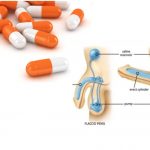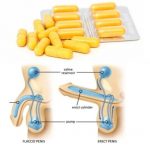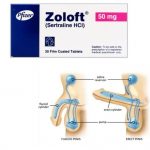What Is The Safest Drug For Erectile Dysfunction?

Erectile dysfunction (ED) is a condition that affects millions of men worldwide, characterized by the inability to achieve or maintain an erection sufficient for satisfactory sexual intercourse. The prevalence of ED increases with age, and it can have a significant impact on a man’s quality of life, self-esteem, and relationship with his partner.
Fortunately, there are several effective treatments for ED, including lifestyle modifications, psychotherapy, vacuum erection devices, penile injections, and oral medications. Oral medications, in particular, are the most commonly prescribed treatment for ED, and they work by enhancing the effects of nitric oxide (NO), a chemical that relaxes the smooth muscles in the penis and increases blood flow.
In this article, we will focus on the different types of oral medications used to treat ED, their mechanisms of action, and their potential side effects and safety profiles.
Types Of Erectile Dysfunction Medications And Their Safety Profiles
Phosphodiesterase Type 5 (PDE5) inhibitors
Phosphodiesterase type 5 (PDE5) inhibitors are the most commonly prescribed oral medications for ED. They work by inhibiting the activity of the enzyme PDE5, which breaks down cyclic guanosine monophosphate (cGMP), a chemical that relaxes the smooth muscles in the penis and increases blood flow. By inhibiting PDE5, these drugs enhance the effects of cGMP, leading to improved blood flow and erection quality.
There are currently four FDA-approved PDE5 inhibitors on the market: sildenafil (Viagra), tadalafil (Cialis), vardenafil (Levitra), and avanafil (Stendra). All of these drugs have similar mechanisms of action and are effective in treating ED, but they differ in their onset of action, duration of effect, and potential side effects.
Sildenafil (Viagra)
Sildenafil was the first PDE5 inhibitor to be approved by the FDA in 1998, and it remains one of the most commonly prescribed drugs for ED. It is taken orally, typically 30 minutes to 1 hour before sexual activity, and its effects can last for up to 4 hours.
The recommended starting dose of sildenafil is 50 mg, but it can be adjusted up to 100 mg or down to 25 mg depending on the patient’s response and tolerability. Sildenafil should not be taken with nitrates or alpha-blockers, as it can cause a potentially dangerous drop in blood pressure.
The most common side effects of sildenafil include headache, flushing, dyspepsia, and nasal congestion. Rare but serious side effects include sudden vision loss or hearing loss, which can occur in rare cases due to decreased blood flow to the optic or auditory nerves.
Tadalafil (Cialis)
Tadalafil was approved by the FDA in 2003 and is similar to sildenafil in its mechanism of action. However, it has a longer half-life than sildenafil, which means that its effects can last for up to 36 hours. This makes it a popular choice for men who want more flexibility in their sexual activity.
The recommended starting dose of tadalafil is 10 mg, taken 30 minutes before sexual activity, and it can be adjusted up to 20 mg or down to 5 mg depending on the patient’s response and tolerability. Tadalafil can be taken with or without food, and it has no restrictions on concurrent use with nitrates or alpha-blockers.
The most common side effects of tadalafil are similar to those of sildenafil, including headache, flushing, dyspepsia, and nasal congestion. However, tadalafil may also cause back pain and muscle aches, which are typically mild and go away within a few days.
Vardenafil (Levitra)
Vardenafil was approved by the FDA in 2003 and is similar to sildenafil in its mechanism of action. However, it has a shorter half-life than tadalafil, which means that its effects typically last for up to 5 hours.
The recommended starting dose of vardenafil is 10 mg, taken 30 to 60 minutes before sexual activity, and it can be adjusted up to 20 mg or down to 5 mg depending on the patient’s response and tolerability. Vardenafil should not be taken with nitrates or alpha-blockers, as it can cause a potentially dangerous drop in blood pressure.
The most common side effects of vardenafil are similar to those of sildenafil and tadalafil, including headache, flushing, dyspepsia, and nasal congestion. However, vardenafil may also cause visual disturbances, such as changes in color vision or sensitivity to light, which are typically mild and go away within a few hours.
Avanafil (Stendra)
Avanafil is the newest PDE5 inhibitor to be approved by the FDA, in 2012. It has a faster onset of action than the other PDE5 inhibitors, typically taking effect within 15 to 30 minutes, and its effects can last for up to 6 hours.
The recommended starting dose of avanafil is 100 mg, taken 15 to 30 minutes before sexual activity, and it can be adjusted up to 200 mg or down to 50 mg depending on the patient’s response and tolerability. Avanafil can be taken with or without food, and it has no restrictions on concurrent use with nitrates or alpha-blockers.
The most common side effects of avanafil are similar to those of the other PDE5 inhibitors, including headache, flushing, dyspepsia, and nasal congestion. However, avanafil may also cause back pain and muscle aches, which are typically mild and go away within a few days.
Other oral medications for ED
In addition to PDE5 inhibitors, there are other oral medications that can be used to treat ED, although they are less commonly prescribed. These include:
Alprostadil
Alprostadil is a synthetic version of prostaglandin E1, a chemical that relaxes the smooth muscles in the penis and increases blood flow. It can be administered in two forms: as an injection directly into the penis, or as a suppository inserted into the urethra.
The injection form of alprostadil is typically more effective than the suppository form, but it requires more skill to administer and may cause pain or bruising at the injection site. The suppository form is less invasive but may cause mild discomfort or burning in the urethra.
Alprostadil is generally safe and effective for the treatment of ED, although it may cause side effects such as pain, burning, bleeding at the injection site, or prolonged erection (priapism), which requires immediate medical attention.
Yohimbine
Yohimbine is a natural supplement derived from the bark of the Yohimbe tree, and it is believed to enhance sexual function by increasing blood flow to the penis and stimulating the production of nitric oxide. However, its effectiveness in the treatment of ED is controversial, and it may cause side effects such as dizziness, nausea, anxiety, and high blood pressure.
Lifestyle Modifications for ED
In addition to oral medications and other treatments, there are lifestyle modifications that can help improve ED. These include:
1. Quitting smoking: Smoking can cause the narrowing of blood vessels and reduce blood flow to the penis, making it more difficult to achieve and maintain an erection.
2. Reducing alcohol consumption: Drinking too much alcohol can also reduce blood flow to the penis and cause ED. It is recommended to limit alcohol consumption to no more than two drinks per day.
3. Maintaining a healthy weight: Being overweight or obese can increase the risk of developing ED. Losing weight and maintaining a healthy weight can improve overall health and sexual function.
4. Eating a healthy diet: A diet that is high in fruits, vegetables, whole grains, lean protein, and low in saturated and trans fats can improve cardiovascular health and reduce the risk of ED.
5. Exercising regularly: Regular physical activity can improve cardiovascular health, reduce stress, and improve overall health and sexual function. It is recommended to aim for at least 150 minutes of moderate-intensity exercise per week.
6. Managing stress: Stress can contribute to ED by increasing cortisol levels and reducing testosterone levels. Practicing stress management techniques such as meditation, yoga, or deep breathing exercises can help reduce stress and improve sexual function.
Conclusion
In conclusion, there are several safe and effective oral medications available for the treatment of ED, including sildenafil, tadalafil, vardenafil, and avanafil. These medications work by increasing blood flow to the penis, and they are generally well-tolerated with few side effects. In addition to oral medications, there are other treatments available for ED, including alprostadil and yohimbine. Lifestyle modifications such as quitting smoking, reducing alcohol consumption, maintaining a healthy weight, eating a healthy diet, exercising regularly, and managing stress can also help improve ED. It is important to talk to a healthcare provider about the best treatment options for individual needs and medical history.





